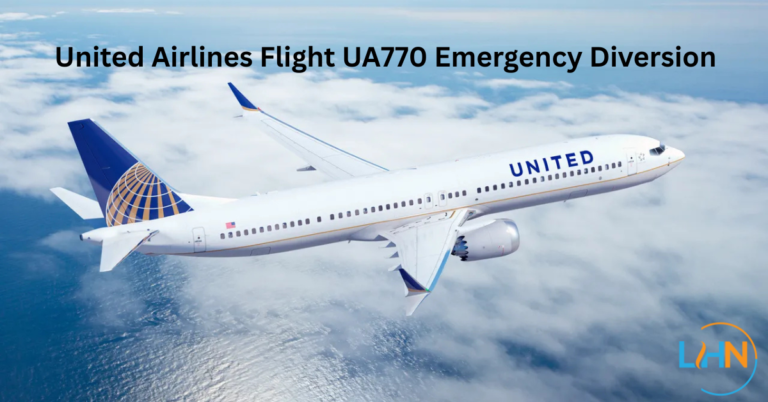Introduction: A Routine Flight That Became Global News
On May 27, 2025, the united airlines flight ua770 emergency diversion became a leading aviation headline. A Boeing 787-9 Dreamliner traveling from Barcelona (BCN) to Chicago (ORD) declared a Squawk 7700 emergency midway across Europe before diverting to London Heathrow (LHR).
For passengers, a diversion like this is unsettling: what caused it? Were they in danger? What happens next? And for thousands searching afterward, the questions were the same.
This guide provides a verified, fact-driven timeline, technical analysis, and passenger rights breakdown, drawing on aviation experts, flight trackers, and official guidance to separate facts from rumors.
Timeline of United Flight UA770’s Diversion
Flight Details
-
Airline: United Airlines
-
Flight Number: UA770
-
Aircraft: Boeing 787-9 Dreamliner, tail number N26902
-
Scheduled Route: Barcelona → Chicago O’Hare
-
Diversion: London Heathrow (arr. 16:55 local time)
The Emergency Code: Squawk 7700
At approximately 14:30 GMT, UA770 squawked 7700, the universal emergency transponder code. This automatically alerts all air traffic controllers that the aircraft is experiencing a critical issue requiring priority handling.
Landing in London Heathrow
-
UA770 landed safely at 16:55 local time.
-
Emergency services were on standby but no injuries were reported.
-
Passengers were rebooked on later flights to Chicago.
Authoritative sources: FlightAware data, Flightradar24 playback, aviation incident logs.
Why Did UA770 Divert? The Cause
The united airlines flight ua770 emergency diversion was triggered by a cabin pressurization system warning. On the Boeing 787, the system is highly redundant, so a single alert doesn’t necessarily indicate imminent danger. However, FAA and EASA rules require crews to divert if safe pressurization cannot be fully assured.
-
Pilot Decision-Making: Heathrow was chosen for its long runways, advanced medical facilities, and United Airlines’ operational presence.
-
Debunking Rumors: No oxygen masks were deployed, and passengers were not in imminent danger. Diversions like this are preventative, not reactive.
How Emergency Diversions Work
-
Diversion vs. Emergency Landing: UA770 was a precautionary diversion, not a forced emergency landing.
-
Air Traffic Control Role: Controllers cleared Heathrow’s airspace to give UA770 priority landing.
-
Passenger Safety Protocols: Crew performed oxygen checks and calmly prepared passengers for arrival.
Passenger Impact & Rights
Many travelers wonder about their rights after an event like the united airlines flight ua770 emergency diversion. Here’s what applies:
-
Airline Compensation (EU261): Safety-driven diversions usually fall outside compensation rules.
-
United Airlines Policy: Hotel accommodations, meal vouchers, and rebooking were offered.
-
Travel Insurance: Some policies cover additional out-of-pocket costs (taxis, meals, hotels).
Expert Insights
-
Captain Mark Davis (Retired 787 pilot):
“Cabin pressurization alerts are treated seriously. Even with redundant systems, crews must prioritize passenger safety through diversion.” -
Dr. Elaine Martinez (Aviation medicine specialist):
“Passengers are rarely in danger in these scenarios. Diversions are proactive safeguards, not signs of catastrophe.”
Frequently Asked Questions (People Also Ask)
Q1: What happened to United Flight UA770?
Ans: The united airlines flight ua770 emergency diversion occurred after a pressurization system warning, leading to a safe landing at London Heathrow.
Q2: Why did UA770 squawk 7700?
Ans: Because Squawk 7700 signals a general emergency to ATC, ensuring priority handling.
Q3: Were passengers in danger?
Ans: No. Diversions like UA770 are precautionary to keep conditions safe.
Q4: Can passengers claim compensation?
Ans: Generally, no, since safety diversions are outside airline control.
Q5: Is flying safe after a pressurization alert?
Ans: Yes. Aircraft undergo full inspection before returning to service.
Conclusion: A Precautionary Diversion, Not a Crisis
The united airlines flight ua770 emergency diversion is a reminder that modern aviation prioritizes prevention over risk. While the headlines made it sound alarming, the reality was a highly trained crew following strict safety protocols, supported by responsive air traffic controllers and ground teams at Heathrow.
For passengers, diversions are disruptive, but they are also proof of the safeguards built into commercial aviation. From redundant systems on the Boeing 787 to international regulations on cabin pressurization, every measure is designed with safety first.
As investigations confirm the pressurization alert was precautionary, travelers can take away this key lesson: diversions are not signs of danger—they are evidence of the aviation industry’s commitment to protecting lives before problems escalate.
For more Latest News, tips, and helpful guides, feel free to visit our website: Life Hack News

